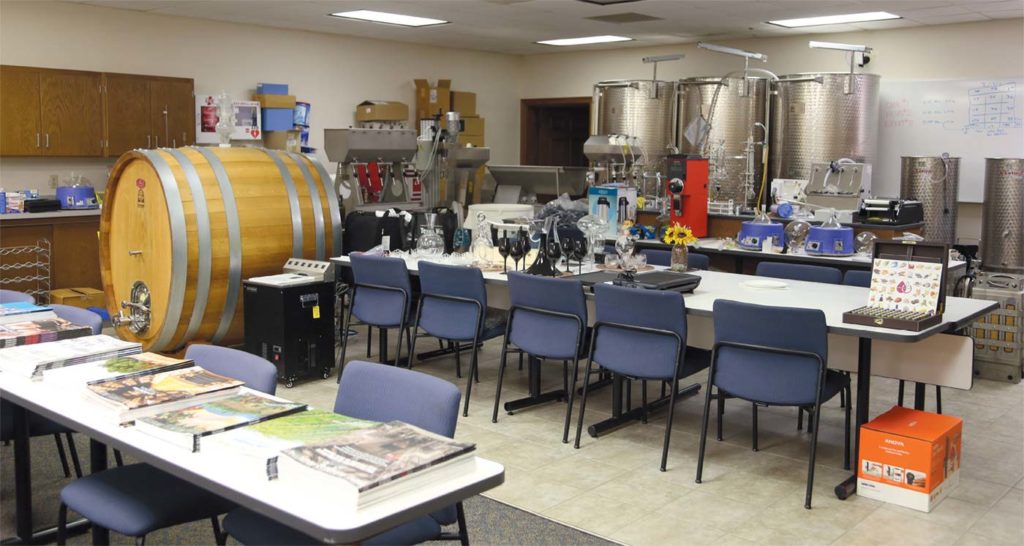
photography Terri Taylor
T.V. Munson Memorial Vineyard sits on a rise of land near the North Texas Regional Airport-Perrin Field. On the day of my visit, a succession of small planes causes havoc for two Australian filmmakers who’ve traveled halfway around the world to interview the director of Grayson College’s Viticulture and Enology Program, Andrew Snyder, who oversees these vines. Despite the sound of noisy aircraft, the Aussies continue filming. Their documentary on the history of wine would not be complete, they say, without a segment in Munson’s namesake vineyard.
“More people in France know of Munson’s work than folks in Texas,” Snyder says as we stroll down a row of trellised vines. “He’s a celebrated figure there, especially in places like Cognac, our sister city.”
In his role overseeing Munson’s legacy, Snyder’s mission begins with reminding modern wine enthusiasts why they should toast a 19th century horticulturist with a penchant for grapes.
“Without T.V. Munson, we might be drinking wine made of strawberries,” he says bluntly.
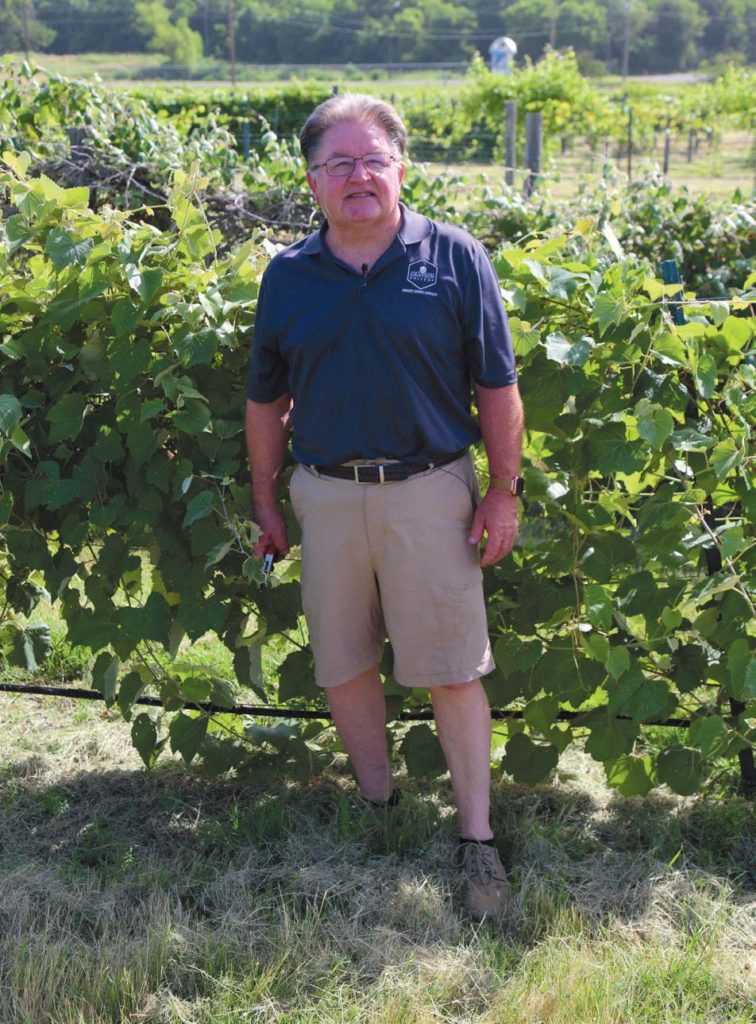
French vineyards represented half of the world’s wine-producing acreage in the mid-1800s when the Great French Wine Blight struck. As grapevines inexplicably withered and died, experts searched for the cause. It wasn’t until the 1870s that microscopic louse called phylloxera were identified as the culprits. These aphid-like insects native to the United States had traveled across the Atlantic in imported rootstock. Though New World vines had become resistant to the pests, the delicate roots of Europe’s vinifera, the chief source of wine grapes, were defenseless. “It’s not just the vines that were under attack,” says Snyder. “Wine was the lifeblood of French culture.”
The devastation soon expanded to the rest of Europe and beyond— South Africa, Australia, New Zealand, South America, and even California. As millions of acres were lost over multiple decades, researchers on both sides of the Atlantic worked without success to solve the problem. The solutions ranged from exorcism and toad venom to chemical compounds and the submerging of vineyards in water. Researchers eventually divided into two camps: those who supported the use of chemicals and the “Americanists,” who believed that the vinifera could be strengthened by grafting European vines onto phylloxera-resistant American rootstock. Though an ancient technique, grafting did not sit well with many French vineyardists angry about the epidemic’s New World origins and fearful that their vines might be compromised by this wild rootstock which produced tart, “foxy” grapes.
As solutions were debated, Munson, a North Texas nurseryman and viticulturist, joined the dialogue. After stints in Kentucky, Missouri and Nebraska, he’d moved his young family to Denison in 1874 and discovered his “grape paradise” growing along the banks and bluffs of the Red River. In their biography, The Grape Man of Texas: Thomas Volney Munson and The Origins of American Viticulture, authors Sherrie McLeRoy and Dr. Roy Renfro describe Munson’s determination to improve the cultivation of American grapes. His first mission was to catalog all vines native to the Southwest, some of which he would use as breeding stock for his nursery’s hybrids. Munson later estimated that he’d traveled over 75,000 miles on foot, horseback and by train. Along the way, he made notes on the terrain.
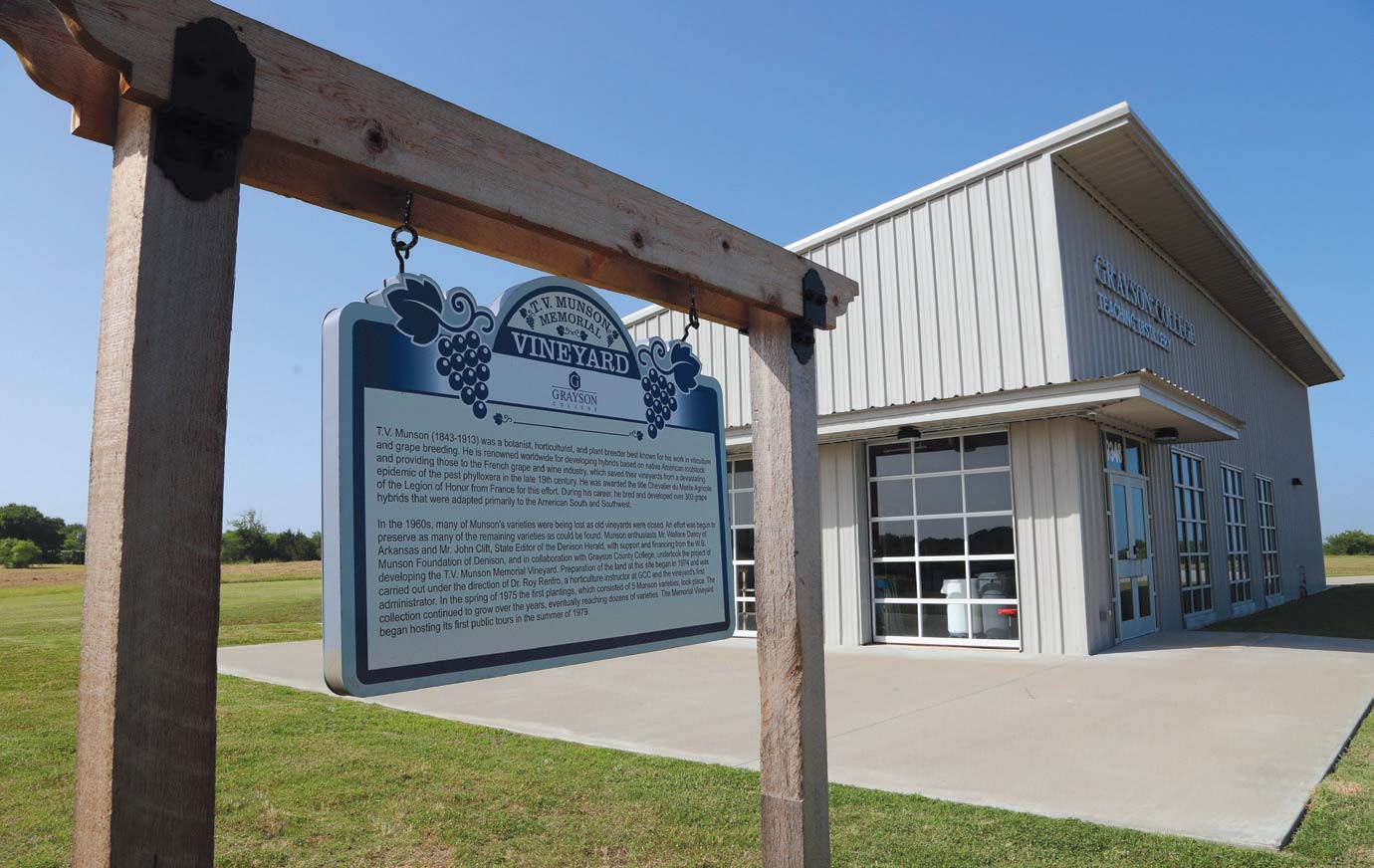
teaching distillery overlooks
the Munson Vineyard.
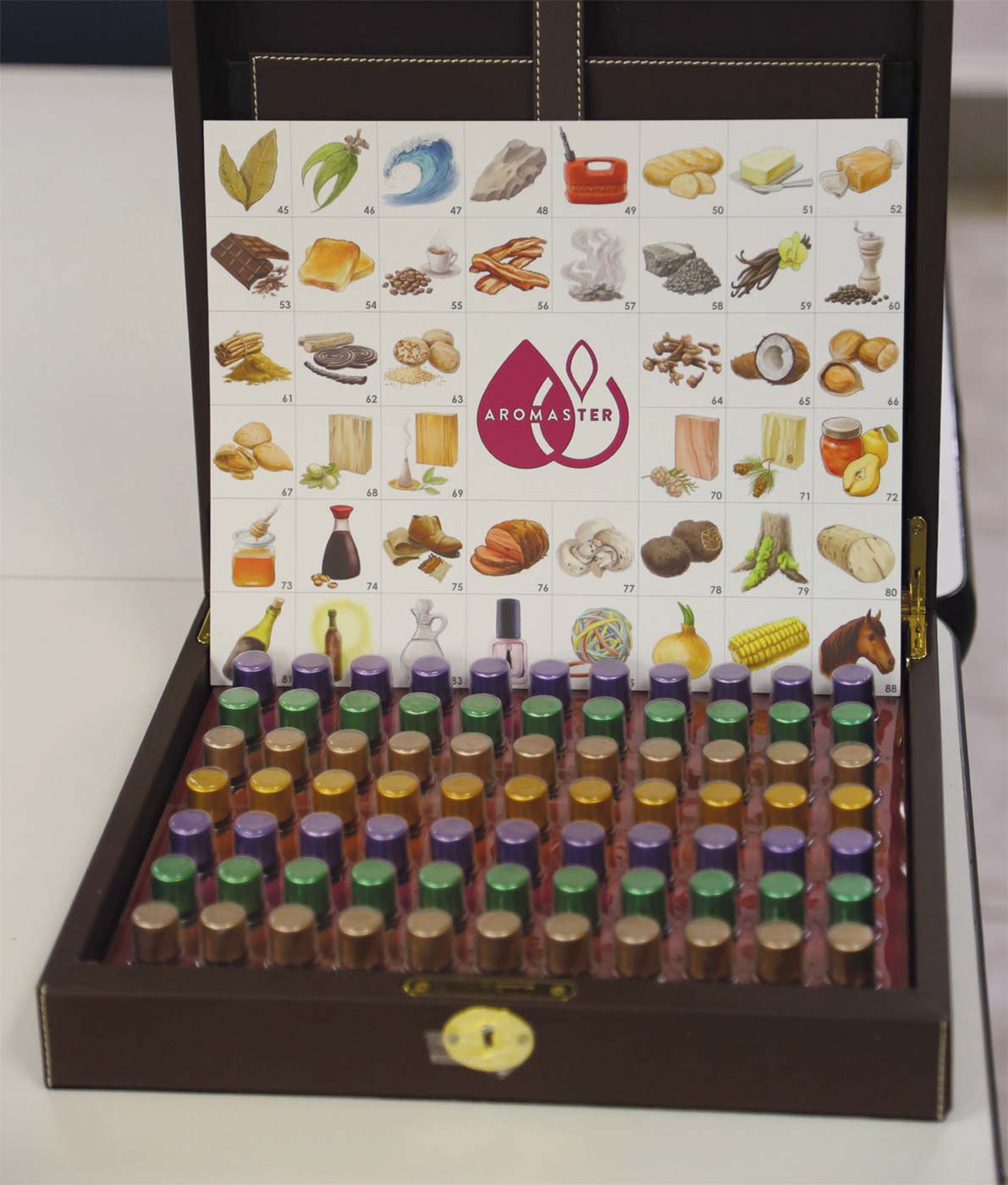
Between 1876 and 1878, the wine community at large decided that grafting was likely the answer. Nurserymen in Missouri, New York and Texas sent shipments of rootstock to France, but when the grafted vines died, progress came to a standstill and the destruction continued.
It wasn’t until 1887 that the French Minister of Agriculture appointed Monsieur Pierre Viala, a professor of viticulture in Montpellier and a correspondent of Munson’s, to resume research in the U.S. Experts had now determined that vines needed to be matched to the soil where they were to be planted. It was a matter of considering the terroir. The new mission was to find American rootstock that might take to the chalky terrain of southern France.
Viala consulted Munson, who zeroed in on the limerich Texas hills near Belton where wild Vitis Berlandeieri and natural hybrids thrived among the scrub oak.
Wagonloads of Texas cuttings were eventually shipped overseas and though the solution would take years to perfect, this was the beginning of the nightmare’s end.
According to McLeRoy and Renfro: “Virtually every grapevine in France, Italy and most of Europe now grows on grafted rootstock which can trace their heritage back to the United States.”
A grateful French government awarded Munson the title Chevalier du Mérite Agricole of the Legion of Honor. On January 6, 1889, the headline of the Fort Worth Gazette read “A Texan Leads the World.”
Munson continued his research, lectured, wrote and dreamed up inventions, all while running a successful nursery business, until his death in 1913.
By the 1950s, Munson’s story had been nearly erased from the pages of history. Only a few nurseries carried his hybrids; his Legion of Honor medal had been sold to a junkman. His legacy might have been lost forever had it not been for his descendants, who in the 1970s were awakened to Munson’s importance by renewed interest in Texas grape production.
The Munson Foundation and its advisory committee, which laid the groundwork for the memorial vineyard, found a worthy partner in Grayson College, already known for its horticultural and agricultural program. The college soon added a viticulture and enology curriculum, one of the first degreed programs in the country, and in 1988, a 5000-square-foot educational center was built near the vineyard. Snyder estimates that 95 percent of students come here with hopes of owning a winery and that 60-70 percent of the state’s winery owners have taken classes there. Alumni know that he’s only an email or phone call away. The program also sponsors a competition for aspiring winemakers with 70 to 80 participants vying for the coveted T.V. Munson Cup.
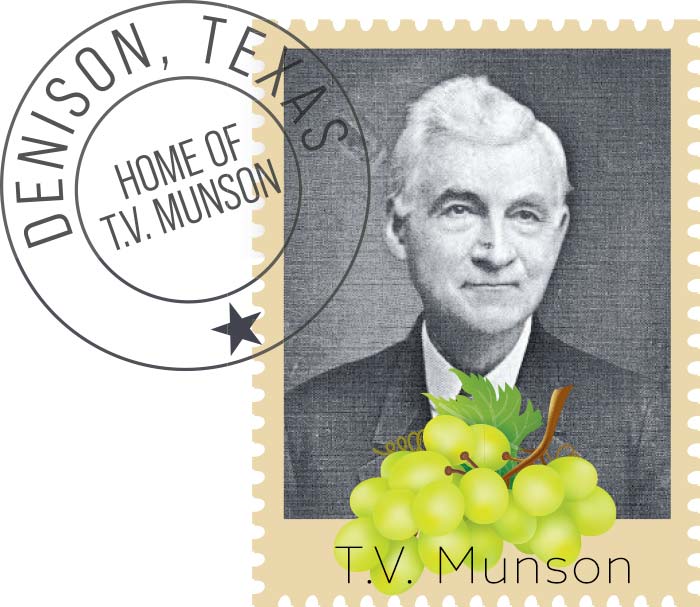
Citing the international awards won by Texas wines, Snyder impresses upon his students the importance of using Texas grapes. “There’s no need for Texas wineries to rely on West Coast juice.” e leafy rows in the 2-½ acre memorial vineyard are filled with dozens of Munson’s time-tested vines, survivors of pests and brutal conditions. As we wander about looking for photo-ops, Snyder explains the vines’ slightly scruffy appearance.
This vineyard will never have the neatly trimmed look of a traditional vineyard, he says, because the goal here is not to produce grapes, but rather rootstock. e task is to grow as much wood as possible, utilizing these mother vines.
The students help harvest cuttings during the dormant season and send them out. Requests come from Munson enthusiasts and from growers and breeders, especially in states like Georgia, Florida and Mississippi, where vinifera have difficulty growing. Grayson has sent Munson’s rootstock to 46 states, asking only for a donation to pay for postage.
In this sharing of the rootstock, the college is keeping Munson’s legacy alive in the most literal way. For Snyder, this is a calling, not a job.
“I’ve been teaching about wine for 20 years,” he says. “And I don’t feel like I’ve worked a day in my life.”
As a kid, TERRI TAYLOR refused to eat her vegetables. Her veggie-phobia was cured in 1977 when she spent eight months working on farms in Norway and France. She studied journalism at UT-Austin and received a master’s degree in liberal arts from SMU. Her short story “Virginia” can be found in Solamente en San Miguel, an anthology celebrating the magical Mexican town of San Miguel de Allende. She has written for Edible DFW since its inaugural issue in 2009. She became the magazine’s editor in 2010 and is the editor of Edible Dallas & Fort Worth: The Cookbook.
-
Terri Taylorhttps://www.edibledfw.com/author/ttaylor/
-
Terri Taylorhttps://www.edibledfw.com/author/ttaylor/
-
Terri Taylorhttps://www.edibledfw.com/author/ttaylor/
-
Terri Taylorhttps://www.edibledfw.com/author/ttaylor/











